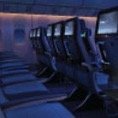Front row seat
February 1, 2016


In-flight entertainment (IFE) isn’t the reason most of us choose to fly with one airline over another.
Business Traveler’s own research has it at 13th place, behind cabin staff, punctuality, and food and drink, but what’s clear is that once onboard, it becomes very important, as demonstrated by the irate messages and letters we get when it fails to work.
There are lots of variables, of course – we are more likely to watch films during the day, while at night we may just want to sleep. Are we in economy class, where there are few other distractions to be had on a long-haul flight apart from a meal service, or business class, where there is more room to move around and recline our seat to get some sleep?
IFE has come a long way. In recent memory, it consisted simply of overhead screens that came down from the ceiling and played one movie, which you could listen to through headphones at your seat.
On long-haul aircraft, this gradually changed to personal screens, then there was the option of choosing channels and, finally, audio-video on-demand (AVOD), giving passengers not only choice but the ability to pause, rewind and fast-forward.
Move on a few more years and the selection of entertainment has vastly increased, with some airlines offering more than you could ever hope to watch or listen to.
Surf in the Sky
Change is continuing apace, not only in the quality of the screens – from HD to a new standard 4K – but the ability to get online while flying.
Connectivity is the new buzzword for inflight entertainment – which for passengers means the ability to surf the web, take phone calls, send e-mails, and have an experience similar to one they would expect on the ground in a café or hotel.
For some passengers, connectivity in the air might be considered a mixed blessing at best. Many don’t want to be reached while flying – they view it as the one time they can relax, or get on with their work uninterrupted, or engage in some “blue sky thinking.” They certainly don’t want to listen to the person next to them on the phone while they are trying to sleep.
Still, most airlines have found they can minimize problems either by turning off the ability to make calls at certain times on night flights, or by appealing to passengers not to do so.
Major Players
Connectivity on aircraft comes in many guises, from allowing passengers to use their phones and data under roaming agreements, as they would if traveling abroad, to the provision of WiFi.
Panasonic has a dominant share of both the inflight entertainment market and of airlines that have committed to inflight connectivity (both satellite and air-to-ground).
It is not the only provider, however; Thales also offers international connectivity and IFE, and providers such as Gogo are particularly strong in the continental US market by equipping airlines like Delta and Virgin Atlantic.
David Bruner, Panasonic’s vice-president of global customer services, cites five main reasons why airlines are installing broadband connectivity.
“First, it’s because passengers want it,” he says. “Yes, there’s an issue of how much they are prepared to pay for it, but in trials where it’s been free, such as on Turkish Airlines, on average 50 to 60 percent of passengers onboard used it at some point. Bear in mind that was the average. So on day flights it would have been much higher, while on night flights lower.”
Bruner says the figures show that, worldwide, some 93 percent of passengers are bringing devices onboard that have the ability to connect to the Internet, and since they are using those devices on the ground, they will want to do so onboard if the price is right (although, at present, that desired price point seems to be next-to-nothing, just as it is on the ground with business travelers demanding free WiFi).
Second, some airlines are introducing it as a USP, reasoning that by doing it first, it creates a good impression with passengers, even as other operators race to catch up.
Third, the connected aircraft also reduces the risk of card fraud and allows the sale of more expensive items – not just duty free, but even activities in the destination to which you are traveling.
Bruner uses the example of a holiday flight to the Seychelles, where the airline could sell a dive package or excursion onboard. With real-time connectivity for the credit card terminal, it reduces the risk of fraud for the airline, and also provides revenue to make up for the cost of providing the WiFi, all while offering a service to customers.
The fourth reason to be connected is operational – information relayed back from individual aircraft could lead to further efficiencies system wide.
Aircraft weather sensors, for instance, provide valuable information on weather forming in the atmosphere, which could be fed back (or sold) to other airlines by companies such as Panasonic. As Bruner puts it: “You can’t control the weather, but if you can predict it, you can respond more effectively.”
Lastly, if there is a fault onboard, the maintenance team would learn about it in real time and, in some cases, be prepared with the necessary part when the aircraft arrives at its destination, cutting down the time taken to make repairs.
Airlines would argue that such operational efficiencies would be passed on to the customer in the form of lower ticket prices, but even if that didn’t happen, anything that reduces the chances of things going wrong with your flight or departure time are to be welcomed.
Ground Forces
For passengers, the ability to send e-mails might be useful, particularly if traveling on business, but when compared with the pace of technological developments on the ground, is it that impressive?
It could be viewed merely as airlines trying to keep up with the technology available in the home. Despite the high cost of installing these systems, touchscreens didn’t debut on aircraft, after all – what’s the big deal?
In part blame it on the harsh environment – both physical and regulatory – that IFE has to operate in. You can’t have a beta version of the equipment flying around while engineers figure out if it’s safe.
It’s also, as Bruner puts it, “about the most expensive place you can think of to provide internet.” In those circumstances, keeping to a price point for WiFi close to that of a hotel – where we all complain if it’s not free – seems like financial suicide.
So why do it? Neil James, executive director of corporate sales and product management for Panasonic, says: “Airlines are making decisions today for the [forthcoming] 777X, and the chances of not having connectivity on an aircraft in 2020 are incomprehensible. Imagine telling the teenagers of today, who from 2020 onwards will be business travelers, that the aircraft won’t be connected.”
Bring Your Own
So what will all of this mean for inflight entertainment systems? Will people use them at all if they are traveling with their own WiFi-enabled devices?
Panasonic’s new prototype “Jazz” seat, which it has developed with seat manufacturer B/E Aerospace, is the answer to this, providing room and support for personal devices while offering what it calls “an upgraded IFE experience.”
“The intention is to have a huge amount of storage onboard the aircraft for the airline to have content that is specific to its personality,” James says.
This will give the passenger “the ability to access the infinite depth of the web,” while “the heavy lifting” – content such as 4K-definition movies, which would take a long time to download to your personal device even at home – would be streamed locally either to the device or the IFE screen.
“The device is connected to the web so it can be streamed, but probably at a low level for ‘snackable’ content, which people will always want to have access to on their devices,” James says. “The bigger content will be stored on the aircraft and streamed to the device.”
The advantage of this new system is that, instead of having to log on to the WiFi with a credit card and create an account, your device becomes what Panasonic calls a “trusted token,” vouching for your identity.
There are various ways this can happen, including “Light ID” technology, which can be used on any device with a camera. Simply point it at the IFE screen, and it sends a signal that tells the system who you are, and synchronizes everything.
Rather ominously, James adds: “It can even display adverts that are relevant to you.” Now that really is like the browsing experience you get on the ground…
CONNECTIVITY PROVIDERS
Aeromobile
Panasonic’s mobile roaming service available on Aer Lingus, Air France, Alitalia, British Airways, Emirates, Etihad Airways, EVA Air, KLM, Lufthansa, Qatar Airways, SAS, Singapore Airlines, and Virgin Atlantic.
GoGo
Gogo offers broadband using wireless signals from network towers across the US. Available on Air Canada, Alaska Airlines, American Airlines, Delta, Japan Airlines, United and Virgin America.
Gogo got FAA’s nod for its 2Ku next generation satellite technology, able to deliver speeds of 70 Mbps to the aircraft – more than 20 times the bandwidth it currently provides. Gogo says seven airlines totaling 500 plus aircraft have signed up for either a trial or fleet deployment.
OnAir
OnAir is a mobile roaming service for inflight connectivity using Inmarsat’s Swiftbroadband services internationally. Find it on Aeroflot, ANA, British Airways, Emirates, Etihad, Iberia, Oman Air, Qatar Airways, Singapore Airlines, TAM and Thai Airways.
By Tom Otley




